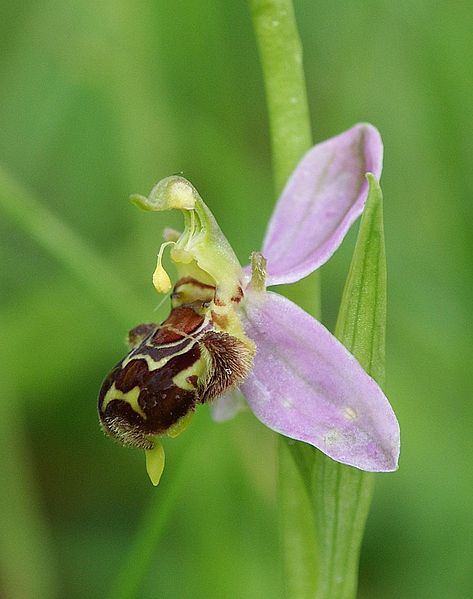
Orchids have developed highly specialized systems pollination and therefore likely to be pollinated are often scarce. That is why flowers of orchids are generally very receptive to long periods and why most orchids provide pollen in a single mass, whenever succeeds pollination of thousands of eggs can be fertilized.
Pollinators are often visually attracted by the shape and colors of the labellum. The flowers produce attractive May odors. Although the absence in most species, May nectar produced in a fork (8) labellum, on the verge of sepals or in the septum of the ovary, the most typical position among the Asparagales.
In orchids that produce pollinia, pollination happens as a variant of what follows. When the pollinator entry into the flower, it affects a viscidium, which quickly sticks to his body, usually on the head or abdomen. While leaving the flower, he pulls the pollinium of anthers, as it is connected to the viscidium by the caudicle or stipe. The caudicle then turns and the pollinium is moved forward and down. When pollinators entering a flower of the same species, pollinium took this position it will stick to the stigma of the second flower, just below the rostellum, pollination. Holders of orchids May be able to replicate the process with a pencil or a similar device.
Ophrys apifera is on the verge of self-pollination
Ophrys apifera is on the verge of self-pollination
Some orchids mainly or wholly rely on self-pollination, especially in cold regions where pollinators are particularly scarce. The caudicles May dry up if the flower has not been visited by a pollinator and Pollina then fall directly on the stigma. Otherwise, the anther May turn and then enter the stigma cavity of the flower (as in Holcoglossum amesianum).
The labellum of the Cypripedioideae is shaped pocket and a function of access to trap insects. The only exit led to anther that the deposit pollen on the visitor.
In some orchids very specialized, like the kind Ophrys Eurasian, the labellum is adapted to have a color, shape and odor that attracts insects males mimic a receptive female. The pollination happens as the insect attempts to mate with flowers.
Many neotropical orchids are pollinated by bees male orchid, which visit flowers to collect volatile chemicals they need to synthesize pheromonal attractive. Each type of orchid pollinia place on another part of the body of another species of bee, so as to apply a good cross-pollination.
An underground orchid in Australia, Rhizanthella slateri, ever see the light of day and depends on ants and other insects land for pollination.
Catasetum, a kind briefly discussed Darwin actually launches its viscous pollinia with explosive force when an insect touches a seta.
After pollination sepals and petals wilt and disappear, but they generally remain committed to the ovary.
Friday, May 9, 2008
Pollination
Labels: orchids, Pollination, scientists, unique flowers
Posted by Salma at 8:53 AM
Subscribe to:
Post Comments (Atom)


0 comments:
Post a Comment